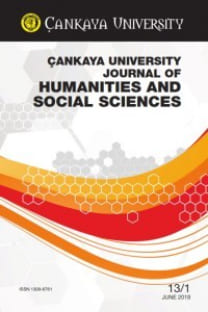Camp X-Ray Üzerinden 11 Eylül Sonrası Amerika’nın Ruh Halini Okumak
2001 yılında Dünya Ticaret Merkezi Kuleleri’nin yıkılması dünya tarihinde yeni bir dönem açmıştır. Küresel bir işaret olarak, 11 Eylül saldırılarını takip eden dönem sadece Amerika Birleşik Devletleri’ne değil, bilhassa Afganistan, Irak, Suriye ve Pakistan gibi bazı Asya ülkelerine daha tedirginlik vermiştir. Hakim olan enkaz görüntüsü, kısa süre sonra Amerikan hükümetinin teröre karşı savaş başlatma yönündeki savunmacı tavrıyla şekillenip yeniden yorumlanmıştır. Amerikan anlayışı çerçevesinde demokratik yollarla etkili bir güvenlik politikasının desteklenmesinin yanında gözetim önlemleri de artırılmış ve bu durum Guantanamo Körfezi’ndeki X-Ray Kampı’nın insanlık dışı bırakmaya hizmet eden kötü şöhrete kavuşmasına sebep olmuştur. Bu makale, 11 Eylül’den yola çıkarak, 11 Eylül sonrası Guantanamo’daki tutuklu kampının, aynı adı taşıyan Camp X-Ray (2014) filminde yeniden anlatılan versiyonunda, özellikle farklılık söz konusu olduğunda insanlık dışı bırakıcı tutumlardan kaçınmayan ulusun temel iktidar söylemine odaklanarak analiz etmeyi amaçlamaktadır. Hapishane sisteminin aksine, Guantanamo’da tutuklular için kurulan kamp, kişinin bireyselliğini silip yerine sonsuz bir hiçlik koymaktadır. Ayrıca bu, Amerika'nın 11 Eylül’den sonraki ruh halini de ortaya çıkarmaktadır.
Anahtar Kelimeler:
11 Eylül, tutuklu kampı, teröre karşı savaş, insanlık dışı bırakma, Guantanamo, Amerika'nın ruh hali
Reading America’s Psyche After 9/11 through Camp X-Ray
The collapse of the World Trade Center Towers in 2001 opened a new era in world history. As a global mark, the period that followed the September 11 attacks brought more unease not only to the United States but to several countries with special damages to some Asian countries such as Afghanistan, Iraq, Syria, and Pakistan. The dominating debris image was soon shaped and reinterpreted by the defensive attitude of the American government to launch a war against terror. Besides promoting an effective security policy by democratic means in the American sense, surveillance measures were also heightened, making Camp X-Ray in Guantanamo Bay notorious for its dehumanizing service. Taking its departure from September 11, this paper aims to analyze the detainee camp in Guantanamo post-9/11 in its retold version in the film with the same name Camp X-Ray (2014) with a focus on the nation’s foundational rhetoric of power that does not abstain from dehumanizing attitudes. Unlike the prison system, the camp in Guantanamo for the detainees erases one’s individuality and offers endless nothingness for the one inside. Also, this reveals America’s psyche after 9/11.
Keywords:
9/11, detention camp, war on terror, dehumanization, Guantanamo, America's psyche,
___
- Anderson, Patrick. ‘There Will Be No Bobby Sands in Guantánamo Bay’. PMLA, vol. 124, no. 5, 2009, pp. 1729–36.
- Butler, Judith. Precarious Life: The Powers of Mourning and Violence. Verso Books, 2004.
- Elshtain, Jean Bethke. Just War Against Terror: The Burden Of American Power In A Violent World. Basic Books, 2004.
- Foucault, Michel. Discipline & Punish: The Birth of the Prison. Translated by Alan Sheridan, Vintage Books, 1977.
- Henry, Patrick. Speech to the Second Virginia Convention. https://www.gleeditions.com/speechtothesecondvirginiaconvention/students/pages.asp?lid=414&pg=4.
- Howard Zinn at MIT 2005 - The Myth of American Exceptionalism. 2019. YouTube, https://www.youtube.com/watch?v=s6ym9B6I3UM.
- Inter-American Commission on Human Rights. Towards the Closure of Guantanamo. 2015. Open WorldCat, http://www.oas.org/en/iachr/reports/pdfs/Towards-Closure-Guantanamo.pdf.
- ‘Islam Is Peace’ Says President. https://georgewbush-whitehouse.archives.gov/news/releases/2001/09/20010917-11.html.
- Kellner, Douglas. ‘Bushspeak and the Politics of Lying: Presidential Rhetoric in the “War on Terror”’. Presidential Studies Quarterly, vol. 37, no. 4, 2007, pp. 622–45.
- Lahur Kırtunç, Ayşe. ‘Kim Bu Amerikalı, Bu Yeni Adam?’ Doğu Batı Düşünce Dergisi, vol. 32, 2008, pp. 97–112.
- Nayak, Meghana V., and Christopher Malone. ‘American Orientalism and American Exceptionalism: A Critical Rethinking of US Hegemony’. International Studies Review, vol. 11, no. 2, June 2009, pp. 253–76. Silverchair, https://doi.org/10.1111/j.1468-2486.2009.00848.x.
- Paine, Thomas. The American Crisis. 1776, http://www.let.rug.nl/usa/documents/1776-1785/thomas-paine-american-crisis/chapter-i---the-american-crisis---december-23-1776.php.
- President: Today We Mourned, Tomorrow We Work. https://georgewbush whitehouse.archives.gov/news/releases/2001/09/20010916-2.html.
- Rosenberg, Carol. ‘What the CIA’s Torture Program Looked Like to the Tortured’. The New York Times, 4 Dec. 2019. NYTimes.com, https://www.nytimes.com/2019/12/04/us/politics/cia-torture-drawings.html.
- Scrimin, Sara, and Enrico Rubaltelli. ‘Dehumanization after Terrorism: The Role of Psychophysiological Emotion Regulation and Trait Emotional Intelligence’. Current Psychology, vol. 40, no. 6, June 2021, pp. 2707–14. Springer Link, https://doi.org/10.1007/s12144-019-00189-x.
- Seitz, Matt Zoller. ‘Camp X-Ray Movie Review & Film Summary (2014) | Roger Ebert’. Https://Www.Rogerebert.Com/, 2014, https://www.rogerebert.com/reviews/camp-x-ray-2014.
- Smith, Caleb. The Prison and the American Imagination. Yale University Press, 2011.
- Smith, David. ‘“It’s Soul-Crushing”: The Shocking Story of Guantánamo Bay’s “Forever Prisoner”’. The Guardian, 7 Dec. 2021. The Guardian, https://www.theguardian.com/tv-and-radio/2021/dec/07/the-forever-prisoner-hbo-alex-gibney-guantanamo-bay.
- Steuter, Erin, and Deborah Wills. At War with Metaphor: Media, Propaganda, and Racism in the War on Terror. Lexington Books, 2009.
- Tindall, George Brown, and David E. Shi. America: A Narrative History. Brief Eighth edition, W. W. Norton & Company, 2009.
- USDOJ: Ten Years Later: The Justice Department after 9/11. https://www.justice.gov/archive/911/. Accessed 22 Aug. 2022.
- Welch, Michael. ‘Guantanamo Bay as a Foucauldian Phenomenon: An Analysis of Penal Discourse, Technologies, and Resistance’. The Prison Journal, vol. 89, no. 1, Mar. 2009, pp. 3–20. SAGE Journals, https://doi.org/10.1177/0032885508329971.
- Winthrop, John. City Upon a Hill. https://www.digitalhistory.uh.edu/disp_textbook.cfm?smtID=3&psid=3918.
- ISSN: 1309-6761
- Yayın Aralığı: Yılda 2 Sayı
- Başlangıç: 2004
- Yayıncı: Çankaya Üniversitesi
Sayıdaki Diğer Makaleler
Book Review: It’s A Stray Dog’s Life by Maximillian Sam
Ütopya ve Distopyanın Diyalektik Anlayışı Perspektifinden Edward Bond’un Diyalektik Tiyatrosu
Orlando Romanında Oluşumlar: Zamansallık, Yazarlık ve Kuir Olmak
Camp X-Ray Üzerinden 11 Eylül Sonrası Amerika’nın Ruh Halini Okumak
Adrienne Kennedy'nin Funnyhouse of a Negro ve The Owl Answers adlı Oyunlarında Kesişen Sınırlar
Direnişi Arşivlemek: Distopya Yazınında Hafıza ve Muhalif Kayıtlar
John Clare’in Tımarhane Şiirlerinde Ev Düşüncesi ve Bellek
Book Review: Wonder Tales in the Fiction of A. S. Byatt. Ed. by Alexandra Cheira
